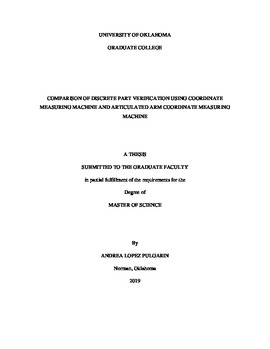| dc.description.abstract | Quality assurance is key in manufacturing and assembling processes and is usually implemented by specifying and controlling tolerances and surface finish of important features, in discrete product manufacturing industry. Much of product verification and inspection for single parts and assemblies are considered to be non-value added, and hence, the processes and procedures must be constantly improved to achieve better savings in time and cost.
Coordinate Measuring Machines (CMMs) are the gold standard for geometry verification of parts in the industry, for their consistency and accuracy. Articulated Arm CMMs (AACMMs) use a scan/arm configuration, and as such are considered not accurate enough in part verification. And yet, they can result in many time-savings and ease of operation. If developed suitably, these can be used quite viably in situations that do not demand high accuracies. It is the aim of this thesis to investigate how the AACMMs compare to the traditional gantry CMMs in flatness verification. Flatness verification is the most fundamental of geometry verification employed in the industry. The success achieved in form verification can be extended to investigate further geometries, and AACMMs can be developed as an economical alternative to the more traditional CMMs in industry.
Specifically, this thesis investigated the flatness of surfaces generated by milling (roughing and finishing). Experiments were conducted on three rectangular blocks of Steel 1018 and three more of Aluminum 6061 of specific dimensions. The CMM employed was used to collect data using three sampling strategies: Hammersley, Halton Zaremba, and Aligned systematic methods. The AACMM was also used to collect the flatness data on each plate through a scan. A commercial Geomagic® Control X™ was used to find flatness deviation between measured data and the CAD model for each of the rough and finish surfaces. Statistics from the distribution of gap distance and deviations were presented through the study. The accuracy was noted in each case.
The results developed verified that AACMM is not as accurate as of the traditional CMM in measuring flatness. All the same, the results were sufficient to suggest that AACMM can be used as a viable and faster alternative to the CMM in flatness verification. | en_US |
